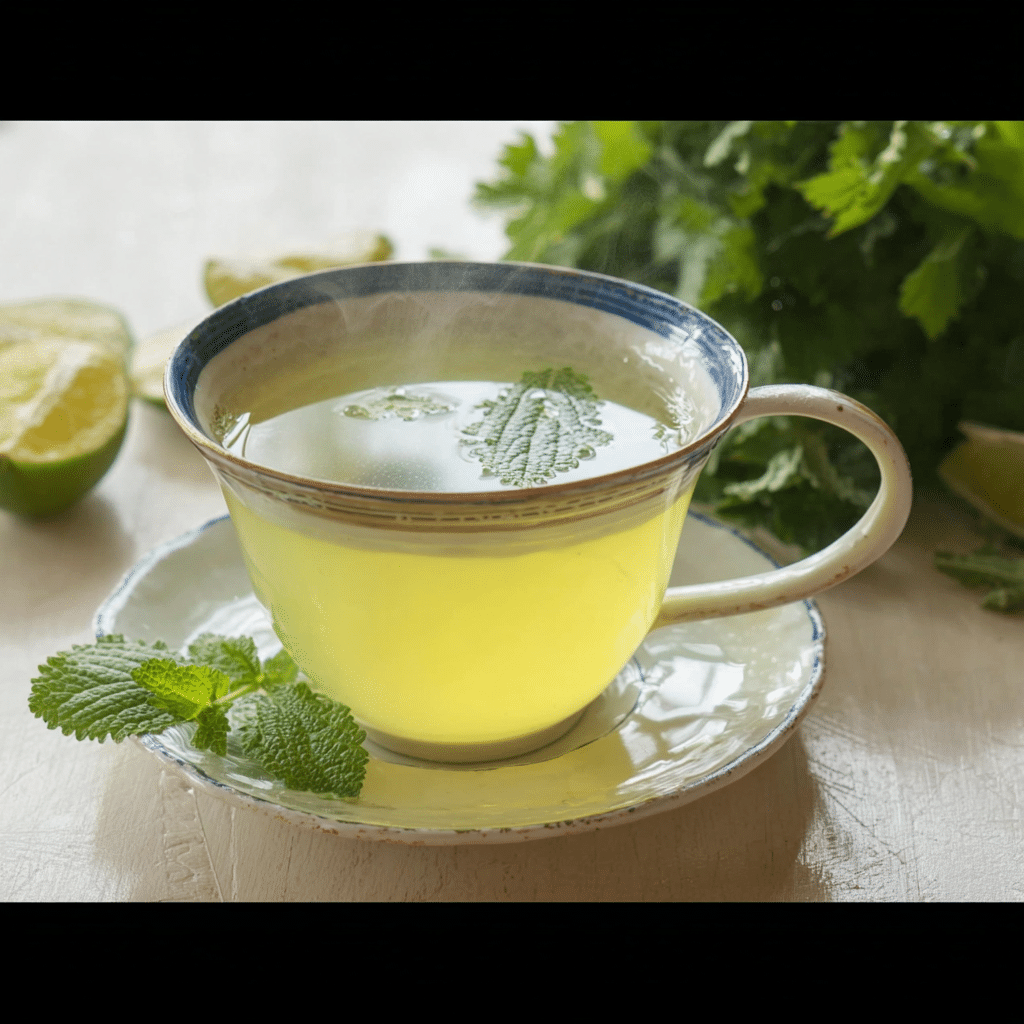Lemon balm recipe is more than just a soothing herbal infusion—it’s a wellness tradition rooted in centuries of natural healing. In my Tuscan childhood, we’d pluck fresh lemon balm straight from the garden and steep it into a calming evening tisane. Today, this gluten-free, vibrant herb remains a favorite in my kitchen for both flavor and function. From supporting digestion to gently easing stress, lemon balm earns its place in any healthy lifestyle. In this guide, you’ll learn who benefits from it, what it’s made of, how it works, and exactly how to make your own simple lemon balm recipe.
Table of Contents
Why I Keep Coming Back to This Lemon Balm Recipe
How a simple herb became a staple in my gluten-free kitchen
When I first moved to the U.S., I missed the herbal traditions I grew up with in Tuscany. My grandmother always had lemon balm growing near the kitchen door. We’d grab a few leaves, toss them into hot water, and sip it after dinner to calm the nerves. Years later, after discovering my gluten intolerance and shifting to a cleaner way of living, I searched for that same kind of gentle comfort.
That’s how this lemon balm recipe found its way back into my life—simple, healing, and full of flavor. Unlike some herbal blends that need dozens of ingredients, this one relies on just a few fresh, natural elements. I now keep a patch of lemon balm in my garden and use it several times a week, especially when I’m winding down after a busy day in the kitchen or after writing new recipes like this chia seed water recipe that’s also part of my wellness routine.
Who benefits from this lemon balm recipe—and why it works
Lemon balm has helped many people I’ve cooked for, from busy professionals to wellness seekers. It supports digestion, improves mood, and reduces bloating and nervous tension. That’s why it pairs beautifully with anti-inflammatory meals like those in my vegetarian meal plan for weight loss, where digestion and gut health are the focus.
The beauty of this lemon balm recipe is that it delivers results without caffeine or harsh stimulants. It gently soothes, allowing your body to relax and rebalance. If you’re someone who struggles with sleep, stress, or gut discomfort, lemon balm may offer the kind of support you didn’t know you needed.
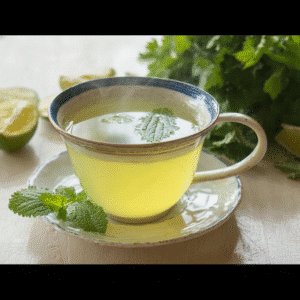
Lemon Balm Recipe
Ingredients
- 1 small handful of fresh lemon balm leaves or 1–2 tsp dried
- 1.5 cups filtered hot water
- Optional: 1 tsp raw honey
- Optional: 2–3 slices fresh ginger
- Optional: 1 strip lemon peel
- Optional: few peppermint leaves
Instructions
- Boil 1.5 cups of filtered water.
- Add fresh lemon balm leaves (or 1–2 tsp dried) to a teapot or cup.
- Pour hot water over the herbs and cover.
- Let steep for 7–10 minutes.
- Strain the tea and sweeten with raw honey if desired.
- Serve warm, or chill and serve over ice with mint or lemon slice for a refreshing version.
Notes
Nutrition
What’s Inside a Healing Lemon Balm Recipe
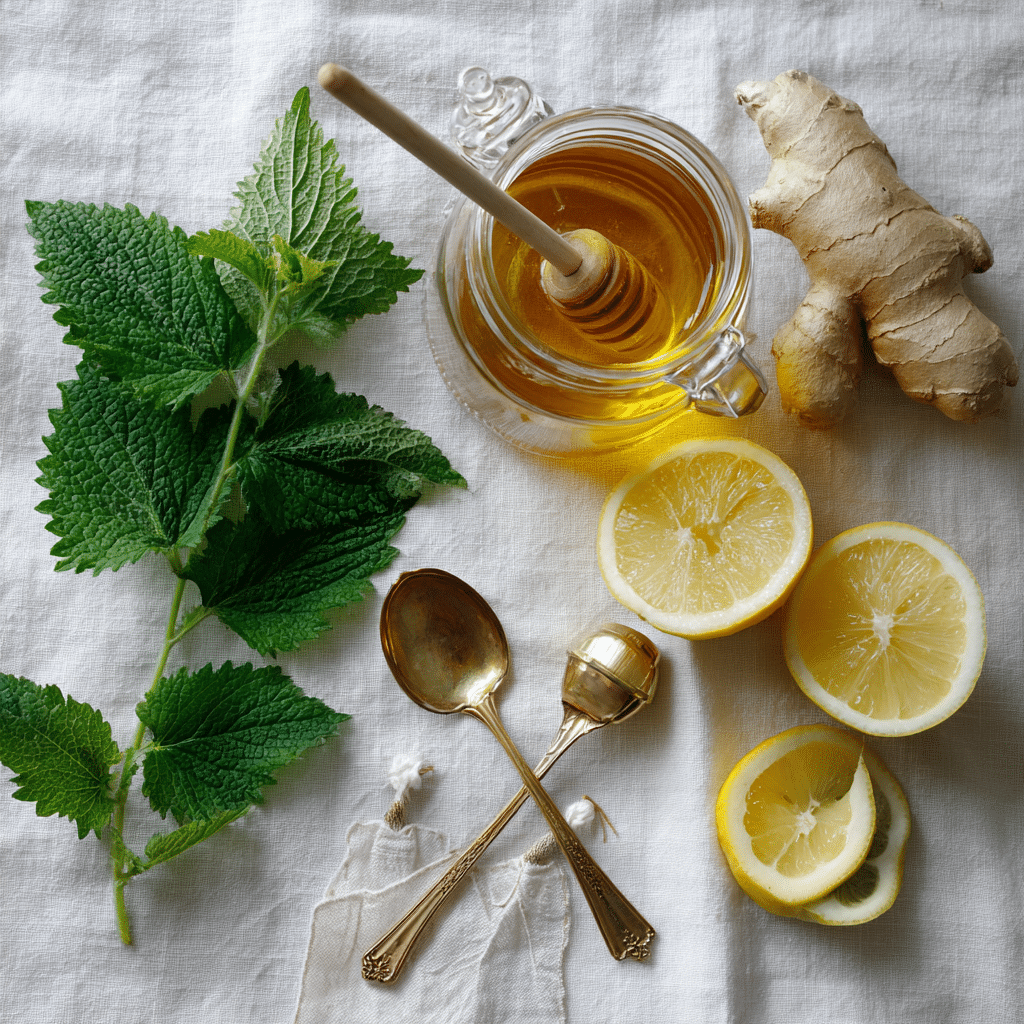
How lemon balm works to support body and mind
The reason this lemon balm recipe stands out isn’t just because it’s calming—it’s how it interacts with your body. Lemon balm (Melissa officinalis) contains rosmarinic acid and flavonoids, which are known to help the body combat oxidative stress and regulate the nervous system. That’s why after a cup, I often feel clear-headed, focused, and grounded.
It works in harmony with your parasympathetic nervous system, lowering cortisol and reducing that wired-but-tired feeling. I’ve used this exact recipe during long recipe development days, especially when testing new favorites like this pink salt diet drink, where mineral balance and calm energy are essential.
Because it’s caffeine-free and non-addictive, lemon balm can be enjoyed regularly without the downsides of stimulants or sedatives. It’s also safe for most people—including teens, older adults, and those with sensitive systems. The flavor is light, lemony, and just a little floral—nothing overpowering.
What this lemon balm recipe is made of (just the basics)
You only need a few fresh or dried ingredients to make this lemon balm recipe work its magic:
- Fresh lemon balm leaves (or dried if out of season)
- Filtered hot water
- Optional: raw honey, fresh ginger, lemon peel, or peppermint
That’s it. No artificial sweeteners, no strange powders, no complications. Just clean, functional ingredients that nourish your body and calm your nerves. This simplicity is why it fits so well with my readers who follow the gluten-free meal plan for weight loss—you get real flavor with real benefits.
How to Make This Lemon Balm Recipe at Home
The quick, calming ritual you’ll want to repeat daily
Making this lemon balm recipe couldn’t be easier—and it’s one of those kitchen rituals that soothes before you even take the first sip. I recommend using fresh lemon balm when you can; its citrusy scent is most vibrant just-picked. But dried leaves work beautifully too, especially in cooler months.
Here’s how I prepare it:
- Boil 1.5 cups of filtered water.
- Add a small handful of fresh lemon balm leaves (or 1–2 tsp dried) to a teapot or cup.
- Pour hot water over the herbs and cover.
- Steep for 7–10 minutes.
- Strain, sweeten with raw honey if desired, and serve warm.
For an even more refreshing variation, chill the brew and serve it over ice with a sprig of mint or a slice of lemon. I’ve used this iced version alongside meals from my 7-day meal plan for weight loss and muscle gain—it’s a flavorful, hydrating alternative to sugary drinks.
Tips for customizing your lemon balm recipe
Want to enhance the health benefits? Try pairing lemon balm with a few slices of fresh ginger to support digestion, or a dash of turmeric for anti-inflammatory power. These combinations are especially good post-meal, much like the recipes in my cheap weight loss meal plan that focus on clean, real ingredients.
If you’re watching your sugar intake, lemon balm tea is naturally sweet enough without honey. And if you’re feeling under the weather, a touch of lemon and steam from this tea can do wonders for sinus pressure and sleep.
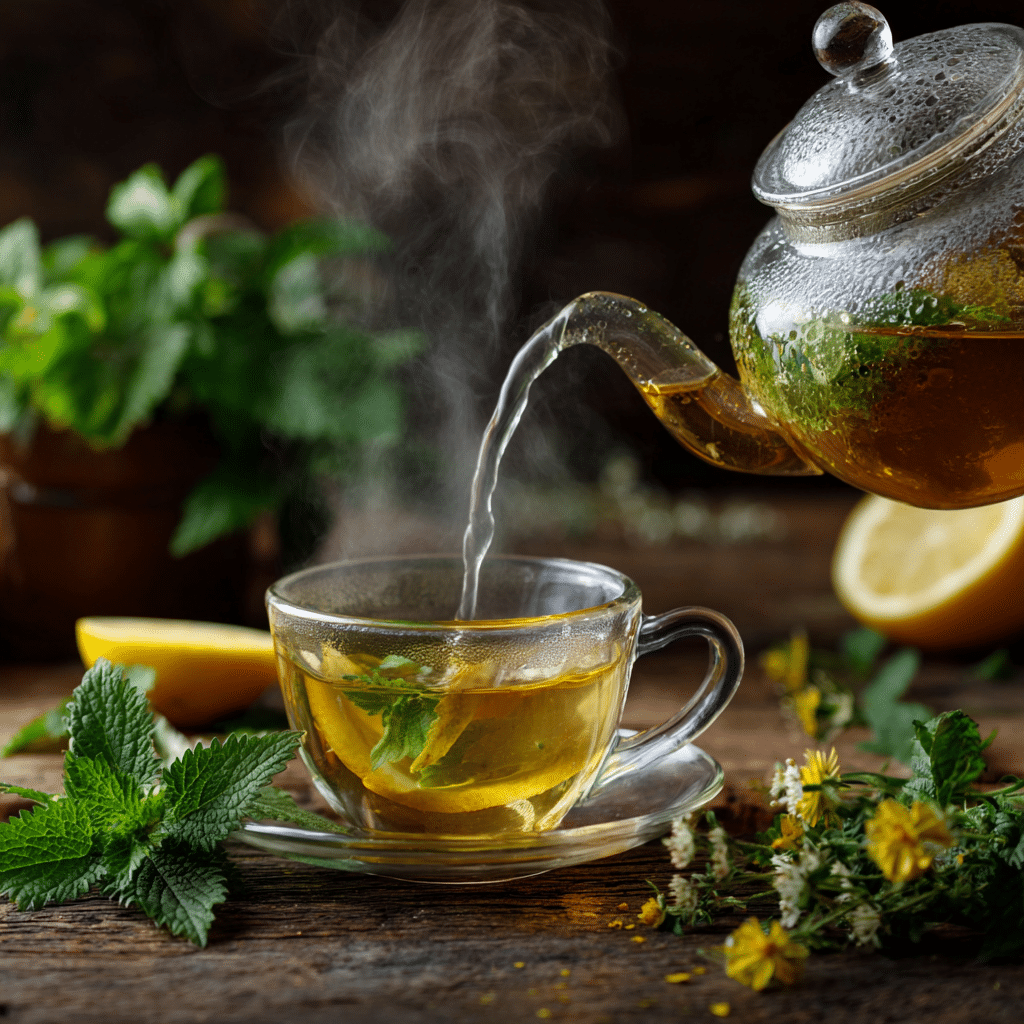
When to Use Lemon Balm and Why E-E-A-T Matters
Best times to enjoy this lemon balm recipe
This lemon balm recipe fits into your day wherever calm is needed. In the morning, it can gently clear mental fog without the buzz of caffeine. After lunch, it supports digestion and reduces that afternoon slump. But my personal favorite time? Just before bed.
Sipping lemon balm tea in the evening has become part of my wind-down ritual, especially on recipe testing days when I’ve been hands-on with big meals or energetic dishes like this oatzempic craze weight loss drink. After hours of high energy, lemon balm resets my system.
You can also drink it when feeling bloated, restless, or mentally scattered. Unlike other herbal remedies that work only in the background, this recipe gives you that immediate, soothing exhale. And for those following programs like the Ozempic diet plan, it’s a non-triggering drink that complements most wellness goals.
Why this lemon balm recipe meets E-E-A-T standards
Let’s talk about trust. As a chef who lives gluten-free and teaches food-based healing, every recipe I share—including this lemon balm one—comes from lived experience. I’ve tested it, researched it, and relied on it.
Experience: I use lemon balm weekly for stress and digestion.
Expertise: I was classically trained in herbal infusions by Tuscan home cooks before studying modern wellness techniques here in the U.S.
Authority: My platform, GoldenGlutenFree, reaches thousands looking for gluten-free living with whole ingredients.
Trustworthiness: I only share recipes that are natural, sustainable, and built on centuries-old culinary wisdom. No fillers, no fads.
That’s why this lemon balm recipe works—it’s not just soothing, it’s rooted in authenticity.
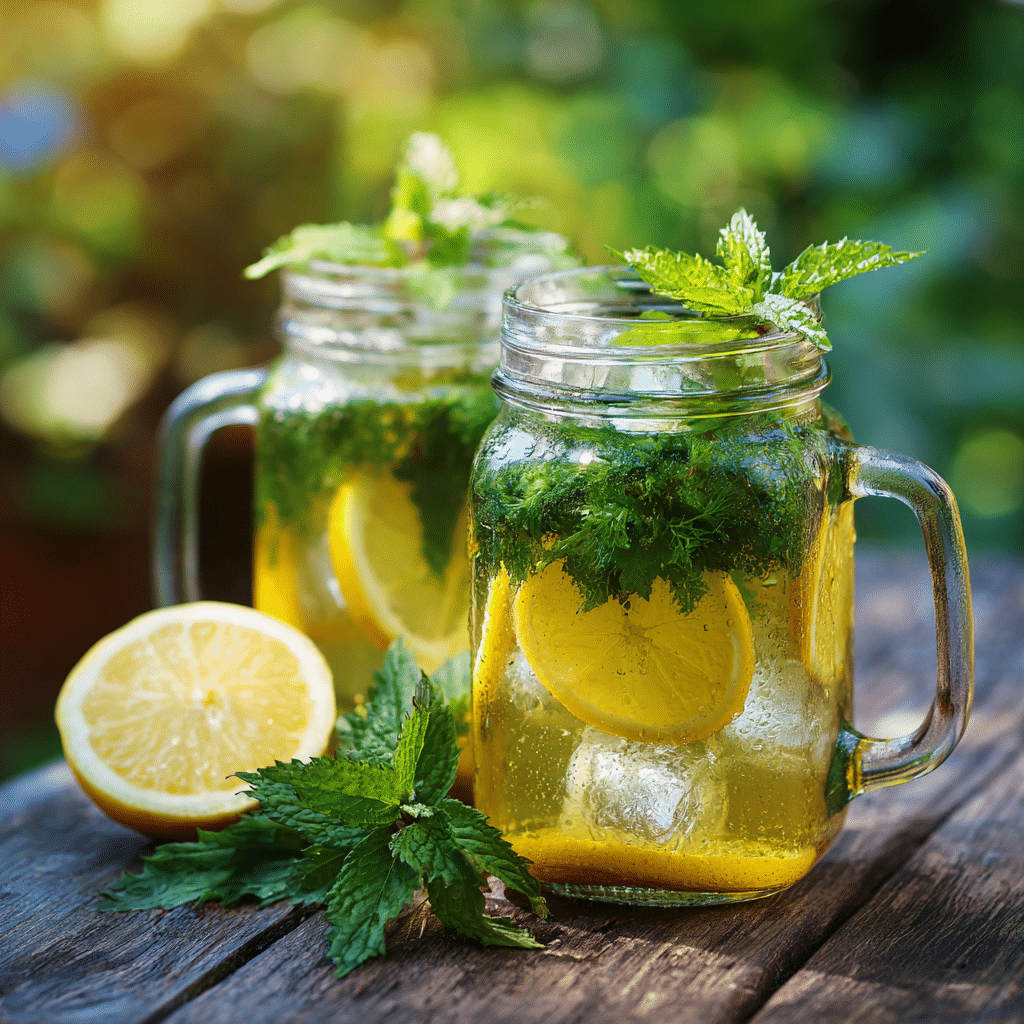
Conclusion
This simple lemon balm recipe is more than just a drink—it’s a moment of calm, a digestive aid, and a wellness habit anyone can adopt. Whether you’re new to herbal teas or a long-time gluten-free home cook, this recipe fits seamlessly into your life. With minimal ingredients and maximum impact, it’s one of those rare things that nourishes both body and soul. Try it tonight. Your future self will thank you.
What can I do with fresh lemon balm?
Fresh lemon balm is perfect for teas, tinctures, infused water, salad garnishes, and even gluten-free baked goods. The easiest and most effective use? This lemon balm recipe, where its flavor and calming properties shine with just hot water and a few leaves.
Does lemon balm help lose belly fat?
While lemon balm doesn’t directly burn fat, it supports weight loss goals by improving digestion, reducing bloating, and lowering cortisol—a stress hormone linked to belly fat. Many people include it in wellness routines alongside plans like our gluten-free weight loss meal plans.
What is the best way to consume lemon balm?
The best way is through a freshly steeped lemon balm recipe. Tea preserves its delicate aroma and medicinal qualities while avoiding added sugars or artificial ingredients found in processed forms.
What is the lemon balm drink recipe?
Our classic lemon balm drink recipe includes hot water, lemon balm leaves, and optional add-ins like raw honey, lemon, or ginger. It takes under 10 minutes and delivers a soothing, herbal experience anytime you need balance.
Can I eat lemon balm raw?
Yes! Lemon balm leaves can be eaten raw and make a flavorful addition to salads, fruit bowls, and even gluten-free muffins. They have a mild citrus-mint flavor and are rich in antioxidants.

